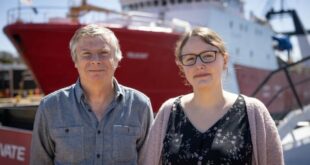‘It’s quite the feat,’ says historian who helped identify structure.

David Saint-Pierre stared at his phone in August after he was sent pictures of a structure divers had spotted on the muddy floor of the St. Lawrence River.
There was something familiar about it and he immediately made the connection. Turned out, he’s been studying it for years but hadn’t actually ever seen it — until then.
He was looking at a table-like structure that had once been on the deck of the Empress of Ireland — a ship that sank off the shores of Rimouski, Que. in 1914. More than 1,000 people on board died in the worst peacetime maritime disaster in Canadian history.
Since then, historians and divers have tried to piece together whatever they can find in the murky depths of the river.
The team that photographed the 2.4-metre square wooden structure thought it might be a table of some kind, lying upside down.
“I knew right away that this was not a table and I was able to identify the compass platform,” said Saint-Pierre. “I happened to have one of the only parts of that platform.”

A maritime historian, Saint-Pierre has spent the last 30 years researching the story behind the sinking of the Empress.
On a foggy May night in 1914, the Empress foundered in just 14 minutes after being rammed by a Norwegian collier. The sinking, just two years after the tragedy of the Titanic, has long been a subject of fascination to Canadians — and maritime historians.
The ship was part of the Canadian Pacific Railway network of transport and had been in service for eight years before it went down.
In Saint-Pierre’s home, safely tucked away in a wooden display case brimming with items and artifacts to be donated to the historic site, he keeps a brass fixture collected in the 90s that once secured that very platform to the deck.
“They placed the main compass of the ship on a wooden platform that would elevate the compass over the structure of the ship,” said Saint-Pierre. “This is what has been found.”

Platform was lost in 90s
In 1964, the structure was discovered underwater and part of the compass, also known as the binnacle, was recovered and is now part of the collection held at the Quebec maritime museum in L’Islet.
The compass platform was officially removed from the wreckage by divers in the 1990s, says Saint-Pierre — prior to the rules put in place which prohibit the removal of artifacts from a protected wreck without special permission from the Ministry of Culture.
While bringing the structure back to shore, divers dropped it, making this summer’s finding the first time they have located it in 30 years.

“It’s quite the feat,” said Saint-Pierre. “The river is almost 50 kilometres wide at that point.”
“We did not have any plans or photos of that platform before it was discovered on the bottom of the St. Lawrence.”

A needle in a haystack
Samuel Côté, a maritime historian who describes himself as a shipwreck-hunter, was part of the team that found the object after triangulating the search area thanks to the help of a friend who had tried to recover the platform in 1994.
“For many reasons, they had to abandon the project and the platform was lost and forgotten for 30 years,” said Côté.
When the team arrived at the location, two kilometres from the original wreck, Côté says they made several passes over the structure before sending divers down.
“It’s pretty rare for this to happen, especially since it’s such a small target. You know, in my career, I’ve identified boats all over Quebec,” said Côté.
“Some of them are 40 or 50 feet long, little tugs. But here we’re talking about a compass platform which is right in the middle of the St. Lawrence.”

The team had to travel eight kilometres from shore and caught sight of the structure 30 metres below the surface during a foggy, rough day at sea.
“We weren’t just looking for a needle in a haystack, we were looking for it in a [barn] full of hay … The first thing we saw were little points that didn’t touch the bottom,” said Côté.
“We said, OK, there’s an anomaly there, but what is it?”

Captain was standing on platform moments before shipwreck
The structure was added to the Empress of Ireland a few months after it was put in service, said Saint-Pierre. He says it had a principal role to play in navigation — and the ship’s eventual demise.
“It’s an object that played a certain role during the fateful night that saw the Empress of Ireland sink,” said Saint-Pierre.
He says the captain, Henry George Kendall, spoke of the compass while delivering his testimony at an inquiry held in June 1914.
“He actually mentions that he was standing on that compass platform when he corrected the direction of the Empress. And that’s where he first personally spotted the Storstad, which was the ship that unfortunately rammed the Empress just a few moments later,” said Saint-Pierre.
“[Kendall] took a couple of very important decisions while standing on that platform. Just a few moments later, returning to the bridge, that’s when the fog came in and everything changed.”

Empress of Ireland sinks in the St. Lawrence in 1914
Heavy fog leads to a deadly collision that kills 1,012 people in Canada’s worst maritime disaster. Retrospective item aired Sept. 23, 1986 on CBC’s The Fifth Estate.
Possibility of removing the object for display at museum
Prior to last month, Saint-Pierre had never seen a close-up image of the compass platform. He hopes teams can get the authorization to remove the piece in order to display it at the museum in Rimouski.
“It takes special permits,” says Saint-Pierre. Even then, it won’t necessarily be easy to move the platform from where it now lies.
“I don’t exactly know if it will be possible to salvage the object, but just the fact that it was discovered on the bottom of the river is already pretty significant.”
ABOUT THE AUTHOR

CBC journalist
Rachel Watts is a journalist with CBC News in Quebec City. Originally from Montreal, she enjoys covering stories in the province of Quebec. You can reach her at rachel.watts@cbc.ca.
*****
Credit belongs to : www.cbc.ca
 Atin Ito First Filipino Community Newspaper in Ontario
Atin Ito First Filipino Community Newspaper in Ontario






